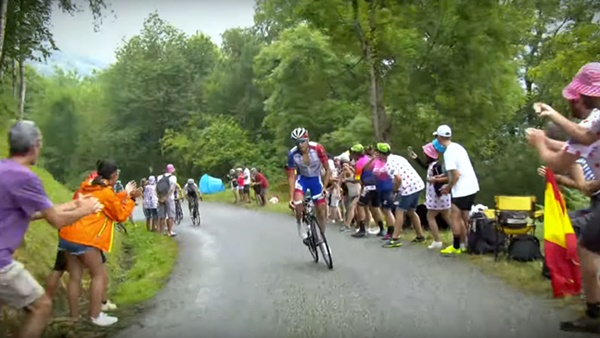
- Main contenders for the 2019 Tour de France
- A recap of stages 1-10
- A recap of stages 11-15
- A recap of stages 16-21
At the start of my first week recap, I said that Julian Alaphilippe was the perfect man to be leading the race. You may have noticed that I then completely failed to explain why that was.
The reason is that for maximum drama, you always want a race leader who’s vulnerable. The optimum situation is for the yellow jersey to be someone likely to fold in the mountains and the guy who’s fourth to be the strongest climber. That way there’s lots of looming excitement.
As things stand, Julian Alaphilippe still leads the Tour de France, but he increasingly looks likely to shed his lead in future mountain stages. Geraint Thomas is second, which would be perfect if it weren’t for the fact that Thibaut Pinot is climbing a lot better than him.
Will Alaphilippe run out of energy? Will Pinot be able to make up his deficit to Thomas? Will anyone ever acknowledge Steven Kruijswijk in third, or are we all just hoping that he fades away in the Alps so that we don’t have to type out his surname again?
Three stages mattered this week. Let’s start with one that didn’t.
Into the Pyrenees
Stage 11 was an irrelevant-to-the-yellow-jersey sprint finish and while stage 12 saw the race enter the Pyrenees, that was also a quiet one. It was interesting though, because Rohan Dennis went awol.
The world time trial champion was the favourite for the next day’s race against the clock, but after 80km he climbed off, refused to speak to anyone and… just disappeared.
As the race continued, Dennis’s team, Bahrain-Merida, put out a statement saying they’d “launch an immediate investigation” into where he’d gone.
He turned up at the bus a few hours later.
There’s still no proper explanation as to what happened. He’s physically fine and it seems that the famously combustible Australian had basically thrown an epic wobbler about something to do with his time trial bike. (Amateur psychology corner: probably because he didn’t feel confident that he’d live up to expectations.)
The time trial
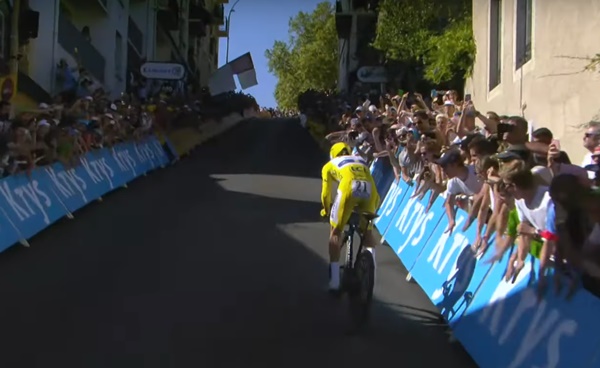
Stage 13 was when Julian Alaphilippe, who very rarely bothers even trying to do well in a time trial, was due to lose a shitload of time to Geraint Thomas, because Thomas is extremely comfortable riding on one of those stupid stretched-out bikes in a sperm-shaped helmet.
This did not happen. What actually happened was that Julian Alaphilippe won the time trial.
Thomas was second, 14s back. Pinot lost another 49s. Plenty of other people lost over a minute. To name a few, Nairo Quintana lost 1m51s, Adam Yates lost 2m08s and Romain Bardet lost 2m26s. In short, things really thinned out at the top of the leaderboard.
At this point, Alaphilippe had won in the hills, which was expected; he’d been among the strongest on a couple of mountain stages, which was more of a surprise; and now he’d got even further ahead in the time trial.
The next big question was whether he could hack a really long climb to high altitude.
The really long climb to high altitude
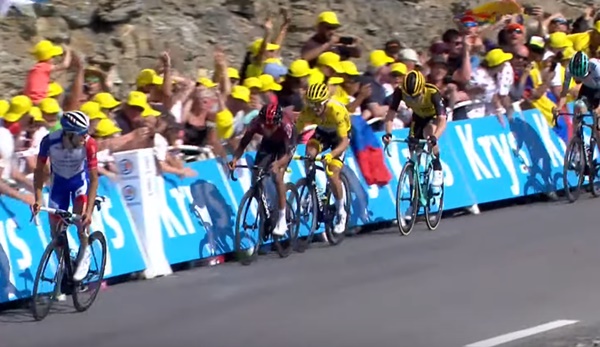
The Tourmalet is a beast of a mountain pass: 19km at 7.4%, topping out in thinner air at 2,115m. Somewhat surprisingly, it ended in a sprint finish.
That wasn’t the intriguing part though. Not really. The intriguing part was the 18.9km leading up to that.
There are two doors out of the peloton: the front door and the back door. People mostly get excited about riders using the front one, going on the attack. The word ‘panache’ gets thrown about.
But there is something purer and more remarkable about a rear exit. When that tiny gap slowly expands before your eyes, you know the rider has nothing left to give. It’s a slow-mo death scene.
The Tourmalet was basically just this, over and over again, for 50 minutes. You never knew who was going to go next.
The five riders who contested that bizarre sprint for the win (Pinot, Alaphilippe, Kruijswijk, Emanuel Buchman and Egan Bernal) were of less significance than the notable names who didn’t – chief among them, Geraint Thomas, who lost 36s.
Plenty of other people lost touch with the front of the race a lot earlier. Quintana was dropped by the pace set by his own team-mates and lost three minutes. Dan Martin lost five. Yates lost nearly seven. Bardet lost 20.
But Alaphilippe survived. He passed yet another test. The next question was could he cope with successive days of long climbs? Could he endure?
Crucially, Pinot won the stage, encouraging the notion that he is currently the fastest up a mountain.
You’ve probably seen the footage of team boss Marc “Allez! Allez!” Madiot urging Pinot on, but it’s worth watching again.
Marc Madiot is a man who experiences emotions.
Yet more climbing

Stage 15 wasn’t as obviously challenging a route as the Tourmalet stage, but it actually involved more climbing overall.
Mikel Landa attacked early and went island hopping, jumping from breakaway team-mate to breakaway team-mate in the hope of winning the stage. He couldn’t catch Simon Yates and was later caught by Pinot, who spent the whole of the last 7km killing everyone and making them feel miserable.
You can do this when you’re the best climber. The Frenchman may have only won by a few seconds the day before, but it told him all he needed to know and he hurt himself as much as he could in the sure knowledge that he could only be hurting everyone else more.
Finally – finally – Alaphilippe was dropped.
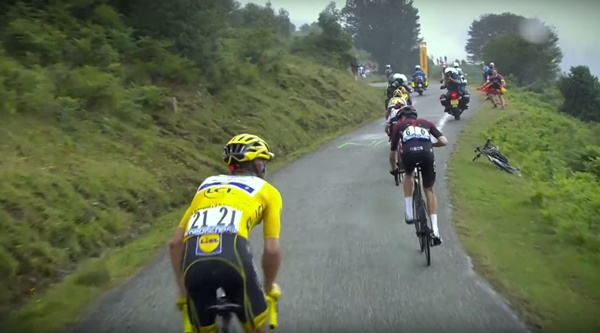
Pinot and Landa (who had a head start remember) finished 18s ahead of Buchman and Bernal; about 50s ahead of Thomas and Kruijswijk; and 1m26s ahead of Alaphilippe.
But in a great coup for the race’s narrative, Alaphilippe is still (somehow) in yellow.
The top ten
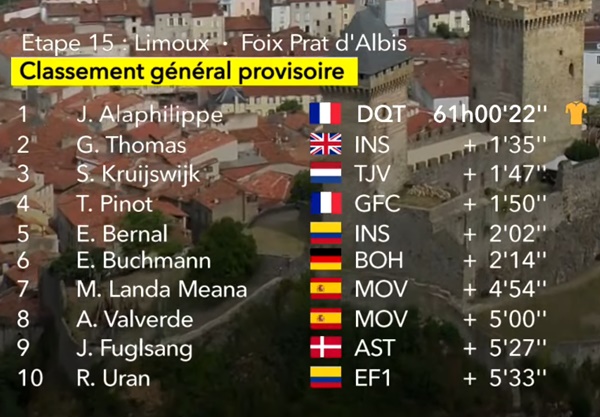
The final week
A six-day week, bookended by stages that are almost certainly irrelevant.
16. Flattest stage of the whole race
17. “Transitional” stage. Pretty flat. Probably not much of note will happen
18. The Col de Vars (9.3km at 7.5%), Col d’Izoard (14.1km at 7.3%) and Col du Galibier (23km at 5.1%). A brutal endurance-fest, downhill to the finish line
19. The Col de l’Iseran (12.9km at 7.5%) and a summit finish to Tignes (7.4km at 7%). Not as obviously intimidating as the day before, but crucially it comes after the day before
20. What on earth? Cormet de Roselend (19.9km at 6%), a quick category two climb after that and then 33.4km at 5.5% to a summit finish at Val Thorens. I’m honestly tired just writing it down
21. Pissing about drinking Champagne and then a quick buzz round the Champs Élysées
In summary: A very tiring race ends with everyone very tired.
I’ll be back on Tuesday (which I know is late, but it’s just when I have time to do this) with my week two recap.
Leave a Reply